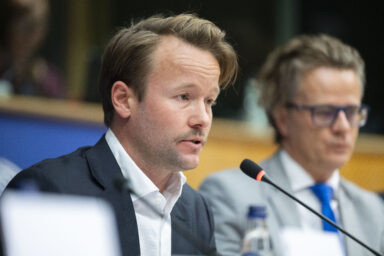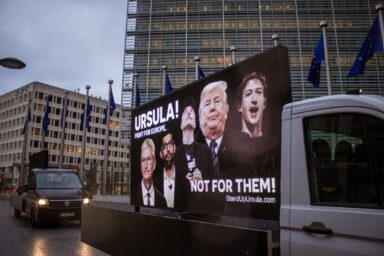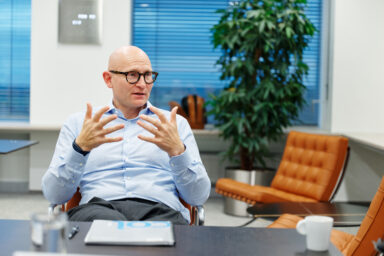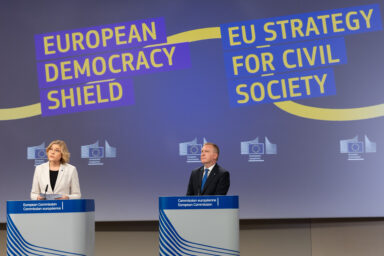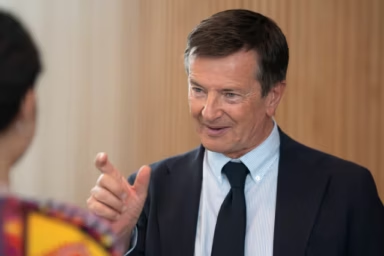Exuberant optimism rang loud and clear through Strasbourg’s corridors of EU power. During Wednesday‘s press conference on the attempted rejuvenation of the bloc’s defence, parliamentarians extolled the virtues of the freshly approved EDIP programme—even as they admitted it is still woefully short of cash.
Europe’s fledgling Defence Industry Programme (EDIP) took a ceremonial bow in Strasbourg on November 26th. The night before, the European Parliament voted the scheme into life from January 1st 2026 (after two years of wrangling). During Wednesday‘s press conference, a sense of relief was palpable. „How sexy is Europe?“ exclaimed MEP Raphaël Glucksmann (S&D/FRA), citing Canada’s interest in SAFE, Europe’s joint defence procurement model.
MEP Marie-Agnes Strack-Zimmermann (Renew/DEU) called EDIP “an important step towards strengthening Europe’s defence capability, even its survival.” She insisted that EDIP will turn “the huge potential of our industry” into kit for Europe’s armies. Money, the German liberal admitted, must follow. The programme’s €1.5bn seed fund, drawn from a wider SAFE instrument, is tiny beside national budgets but is intended to coax governments into joint procurement. Arms bought together will, in principle, be built together; inside the European Union and under European control.
Growing up, at last
Parliament believes it has avoided disproportionate dependence on “formerly dependable partners”. Ms Strack-Zimmermann warned that Russia’s war shows how fast trust can vanish. EDIP, she said, can “encourage member states to enter into common defence procurement” while binding Ukraine into Europe’s industrial base. Implementation now shifts to squaring the numbers in the EU’s multi-annual budget.
Mr Glucksmann supplied the day’s rhetorical thunder. “Do you trust Donald Trump and J.D. Vance to defend our continent?” he asked. “If you don’t, then Europe has got to finally become an adult and assume responsibility for its own defence.” He dubbed EDIP “the first stone in a common defence industrial base”, the only truly European tool in any re-armament plan.
You might be interested
Parliament extracted one early trophy: a hard deadline. “In the final text, we talk about the imperative nature of assuming design authority over military equipment prior to 2033,” Mr Glucksmann said. Controlling blueprints shuts the door on foreign licensing and feeds Europe’s factories. Yet victory felt incomplete. “EDIP is underfunded,” he conceded, vowing pressure to swell its purse and to tap frozen Russian assets for Ukraine’s benefit.
François-Xavier Bellamy (EPP/FRA) supplied the cold statistics. “79 per cent of our armaments and military equipment was purchased outside the EU last year,” he noted. Europe believes in the Atlantic alliance, he said, “but the US are our allies—they’re not our sovereign.” In future, joint purchases will qualify only if at least 65 per cent of components are European and if design control stays in European hands.
A stepping stone
That promise runs into arithmetic. The €1.5bn pot, even when mirrored by SAFE and topped up by member-state co-financing, will struggle to rewrite procurement habits. Mr Glucksmann had argued for a sum “ten times higher”. The looming review of the EU’s seven-year budget and talk of common borrowing will test political appetites that remain uneven across the bloc.
Industry scents an opportunity. Ms Strack-Zimmermann said the private sector “is well ahead of politics”, already mixing supply chains across borders. Mr Bellamy pushed for a dedicated slice of EDIP cash for small firms, hoping a leverage effect will multiply the initial outlay. Canada, Britain and Norway—non-EU countries—have signalled interest in plugging into the scheme. They will, Ms Strack-Zimmermann promised, have to pay to play.
Europeans assumed the United States would help us, and that Russia would provide energy for ever. — MEP Marie-Agnes Strack-Zimmermann (Renew/DEU)
Even so, headwinds howl. Twenty-seven governments, twenty-seven armies and a legacy of mutually exclusive specifications leave little room for speedy convergence. Mr Glucksmann likened Europe to Tanguy, the French cinematic man-child who refuses to leave his parents’ home. Cutting ties to Washington—and to the global market—will prove hard.
Late, but not too late
Asked if the project comes “five to ten years too late”, Mr Glucksmann replied with candour. “Yes, it’s arriving late. Should we have done this before? Yes. Could we have done this before? No.” The Oval Office dressing-down of Ukraine by Mr Trump and MAGA allies jarred Europeans into action, he argued. Now, with “one minute to midnight”, speed must replace complacency.
Ms Strack-Zimmermann reminded listeners why complacency reigned. Europeans assumed “the United States would help us” and that “Russia would provide energy” for ever. Both assumptions died in the Donbas trenches and the Nord Stream gas pipes. With 450 million citizens, she insisted, Europe has the brains and the cash. What it lacks is habit. “This is the biggest challenge,” she said. “We have to work together.”
Mr Bellamy judged the delay even starker: “No, it’s 50 years late.” The old belief that shopping abroad is faster than building at home, he said, is an illusion. States hoard capacity when crises loom. Europe’s “exceptional industrial base” exports civilian goods worldwide; it can export tanks and missiles too.
The road ahead
EDIP’s rules now move from parchment to production lines. From 2026 joint buyers must align contracts with the new 65 per cent threshold and prove design sovereignty. Auditors will crawl over certificates; lawyers will parse clauses. Supply chains will need rewiring, particularly in micro-electronics and propulsion systems, where American content runs deep.
Money remains the largest hurdle. The trio of MEPs pleaded for a fatter envelope in the next EU budget. Mr Bellamy would rather redirect existing funds than issue debt; Mr Glucksmann is open to loans if that is what it takes. Either way, political gusto must survive the grind of budget negotiations and national vetoes.
We can do this. Wir schaffen das. — MEP Raphaël Glucksmann (S&D/FRA)
Outside partners may yet sweeten the pot. Ms Strack-Zimmermann expects countries “who are not members” to join and “ensure the money flows into EDIP”. Their eagerness flatters Europe’s ambitions but also sets a test: if the programme flounders, pledges will melt away faster than a Strasbourg snowfall.
Resolve to replace illusions
For now, optimism drives the narrative. “We can do this. Wir schaffen das,” Mr Glucksmann declared. It was somewhat unexpected, given the slogan’s association with unpopular policies of Angela Merkel, erstwhile German Chancellor (on mass immigration).
Ms Strack-Zimmermann, however, decided to echo Mr Glucksmann, calling EDIP “one step” towards a market that gives Europe the weapons it needs, when it needs them. Mr Bellamy, recalling the comma-by-comma battles of the past months, insisted that Parliament has forged a template for every future defence instrument.
Yet the gulf between aspiration and arsenal yawns wide. Ukraine’s winter war underscores the cost of delay; America’s electoral calendar darkens the horizon. EDIP offers Europe a chance to grow up. Whether the continent proves adult enough to fund, build and field its own armaments remains, for now, an open question.



